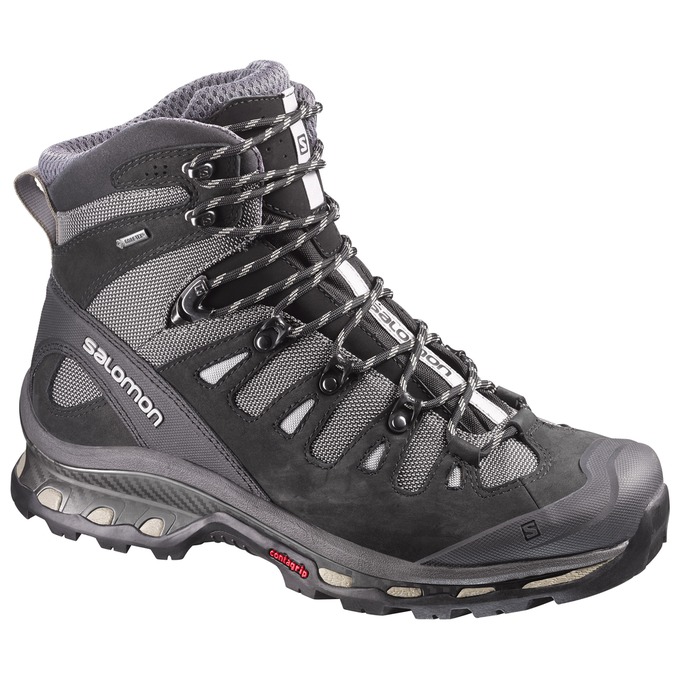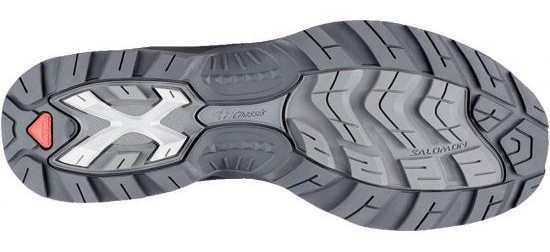
Salomon Quest 4D 2 GTX
Stated Features:
- Gore-Tex Performance comfort membrane for waterproof, breathable protection
- Nubuck leather and textile upper is durable, breathable, and lightweight
- 4D Advanced Chassis provides stability and support
- OrthoLite sockliner and molded EVA midsole for cushioning and stability
- Contagrip outsole ensures traction on rugged terrain
- Lace locker keeps laces in place for a secure fit
Size Tested: 10.5
Stated weight: 640 g per shoe
MSRP: $230
Test Locations: Solukhumbu District, Nepal; Wasatch Mountains, UT.
Days Tested: ~35
Intro
The Quest 4D 2 GTX is Salomon’s flagship, heavy-duty backpacking boot, and the previous version had been a staple in their line for several years. I bought a pair of the first iteration in 2008 and only in the past year — after hundreds of miles and years of wear — did I finally feel the need to try a new pair. After such a positive experience with the previous version, I was eager to see how the updated model performed. To do so, I used the Quest 4D 2 GTX during 5 weeks of travel and backpacking in the Solukhumbu region of Nepal.
Fit
Fit is, of course, very important in hiking boots, and since everyone’s feet are different, we always recommend trying on boots before buying. With that caveat, I’ll talk a bit about the fit of the Quest 4D 2 GTX in general and how it fit my feet, as will Blister reviewer, Luke Koppa, who has also used this boot.

I have narrow feet with a average-high arch, and the Quest 4D 2 GTX fits my foot better than any shoe I’ve ever worn, and I’ve never had any blisters. Luke, who has a wide forefoot and low arch / instep, had a similar experience with a great fit out of the box and no blistering issues.
Construction
The upper of the Quest 4D 2 GTX consists of an abrasion-resistant textile with thin nubuck leather overlays. Unlike boots with thick, stiff leather uppers, the flex and feel of the upper on the Quest 4D 2 GTX stayed the same throughout my testing period.
The insoles in the Quest 4D 2 GTX are simple with little arch support, but I haven’t felt the need to swap them for something more supportive. However, I do have one tiny gripe with the insole: It’s made of an Ortholite foam and a separate EVA heel cup, and there’s a small groove between the pieces that tends to collect dirt, pine needles, and tiny rocks that can wiggle in while hiking and become a nuisance.
The gusseted tongue is lower profile than past models and relatively stable, though I noticed it did tend to migrate to the outside on longer hikes.
Waterproofing
The Gore-Tex lining in the Quest 4D 2 GTX is unsurprisingly waterproof — my feet never got wet when walking through creeks or in drenching rain. The gusseted tongue makes the boot totally waterproof up to about 5 inches above the ground. The waterproofing obviously results in a breathability tradeoff, but the upper zones aren’t so thick that I found it unbearable to use the Quest 4D 2 GTX in extremely hot weather.
Sole
The Quest 4D 2 GTX features Salomon’s proprietary Contagrip sole, and I’ve been pleased with its level of grip, protection, and support. Many boot manufacturers turn to Vibram to make their soles, but, from my experience with the Quest 4D 2 GTX, the Contagrip rubber performs just as well as comparable Vibram soles.

The midsole of the Quest 4D 2 GTX is relatively stiff, but not so stiff that it’s like walking in mountaineering boots. I don’t generally feel small rocks underfoot, and the rubber around the toe also provides excellent toe protection.

Sometimes I’ll get lazy with my steps and kick a few rocks throughout a long day on the trail, but I’ve never had any painfully stubbed toes while wearing the Quest 4D 2 GTX. However, when trying to use trail runners or lighter hiking boots, I’ve stubbed toes so badly that I had to end my hike then and there.
Lacing
The lacing mechanism of the Quest 4D 2 GTX performs very well. Below the ankle, low-friction plastic lace loops make it easy to tighten and loosen the boot, but still keep everything tight and secure once tied. When hiking uphill, I’ll generally leave the upper zone slightly looser, and tighten it up when going downhill. There is a locking mechanism at the ankle that is very dependable, and after the day’s hiking is done, I’ll generally use the ankle locks and keep the uppers entirely loose for walking around camp.
Weight, Break-In, & Support
At a stated weight of 640 g (22.58 oz), the Quest 4D 2 GTX is not light when compared to many low-top hiking shoes. However, its weight is much more reasonable when considering the support and burly construction of the boot.
I received the boots only a few days prior to leaving for Nepal (I would NOT recommend this strategy when buying boots), but the break-in time was relatively fast and painless (Luke reported a similarly short break-in time).
Although there’s been an increasing number of hikers that favor low-top hiking shoes or trail runners for backpacking, I personally prefer the extra stability of a boot like the Quest 4D 2 GTX. Overall, the Quest is very supportive — I’ve never rolled an ankle or had any issues with stability, which is impressive.
Durability
After a month of heavy use, the Quest 4D 2 GTX has fared well overall. The rubber toe wrap shows few signs of wear, and the same can be said for the sole. The area where the plastic midsole chassis is exposed definitely shows some scrapes, but this construction was used on my previous pair and it held up well during several years of use, so I am not too worried about it.

The only point of concern throughout the testing period was with the upper material around the heel. I walk fairly duck-footed, and inevitably my heels would knock together throughout the day as I got tired. The seam between the leather and nylon on both boots has split, leaving the leather frayed so that it sometimes catches on the other boot — something that I also experienced with the previous version. That said, this issue didn’t result in further splitting or a decrease in waterproofing, and Luke has reported that he has not had the same problem arise with his pair.
Bottom Line
As with the previous version, I’ve been very impressed with the Salomon Quest 4D 2 GTX boots. They’re supportive, fairly light, waterproof, and (apart from the small issue of the heel seam) — durable. They provide good traction, adequate ankle support, and have proven comfortable in both desert and mountain conditions.
On top of all this, they have a short break-in period and provided a great fit for two different foot types. So, for those looking for a supportive, all-around backpacking boot, I’d highly recommend the Quest 4D 2 GTX.

BEWARE Salomon will not stand behind their products got a pair that was miss sized after owning 3 pair previously first problem I’ve ever had and their warranty dept. gives reasons like “some boots fit different” same kind as before it’s just a bunch of crap to get out of replacing them